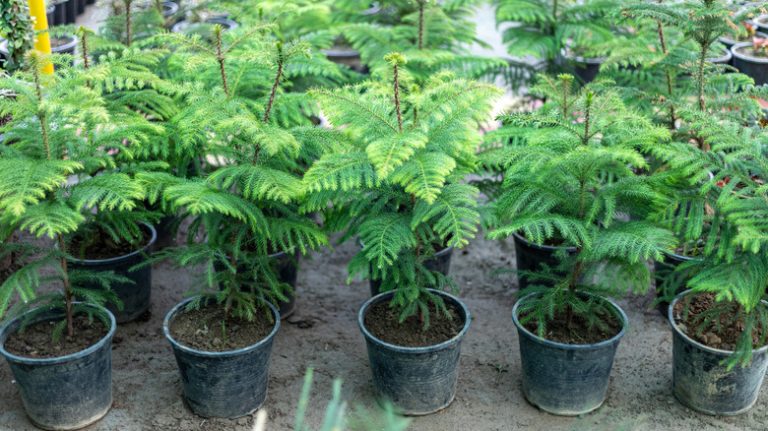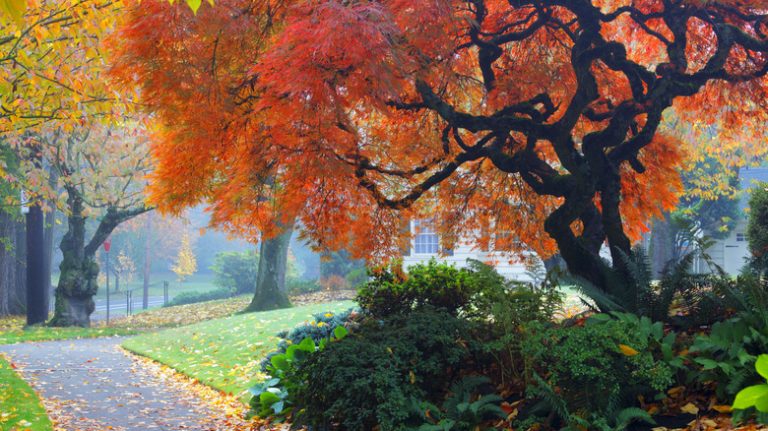The Lacecap Hydrangea is a beautiful and versatile flowering plant that is perfect for any garden. With its delicate lace-like flowerheads, this plant adds a touch of elegance to any landscape. Whether you’re a novice gardener or an experienced pro, the Lacecap Hydrangea is a must-have for your collection.
One of the benefits of growing a Lacecap Hydrangea is its adaptability to various soil types and light conditions. These plants can thrive in both full sun and partial shade, making them suitable for a wide range of garden settings. They also prefer well-drained soil, so make sure to amend the soil if needed to ensure proper drainage.
When it comes to caring for your Lacecap Hydrangea, fertilizing is key. Use a balanced, slow-release fertilizer to feed your plant in early spring and again in early summer. This will help promote healthy growth and abundant blooms. Additionally, deadheading the spent flowerheads can encourage more blooms throughout the season.
If you’re looking to add more color to your garden, the Lacecap Hydrangea has got you covered. With its wide range of colors, including shades of pink, blue, purple, and white, there’s a variety to suit every gardener’s taste. From the classic ‘Zorro’ to the stunning ‘Twist-n-Shout®’, there are endless options to choose from.
Propagation of Lacecap Hydrangeas can be easily done through layering or by taking stem cuttings. If you’re new to propagating plants, it’s best to start with a well-established plant. Purchase a young Lacecap Hydrangea from a reputable nursery, like Proven Winners®, and follow the specific instructions provided.
In colder climates, frost protection is a must for the Lacecap Hydrangea. Mulching the base of the plant with a layer of organic material, such as compost or leaf mold, can help insulate the roots from cold temperatures. Additionally, covering the plant with a frost cloth or burlap can provide extra protection during harsh winter months.
As for companion plants, the Lacecap Hydrangea looks stunning when planted alongside other shade-loving plants like ferns, hostas, and coral bells. Its lush foliage and delicate flowers create a beautiful contrast against the other plants in the garden. Be sure to consider the height and growth habit of the companion plants to ensure a harmonious arrangement.
With proper care and attention, your Lacecap Hydrangea will reward you with years of beauty and enjoyment. Whether you’re looking for a focal point in your garden or a stunning addition to your flower beds, the Lacecap Hydrangea is sure to impress. So, don’t hesitate to add this versatile plant to your next gardening project.
How to Grow and Care for Lacecap Hydrangea Bushes
Lacecap hydrangeas, known for their beautiful flowers and elegant foliage, are a popular choice for gardens. If you want to add these stunning plants to your garden, here are some essential tips on how to grow and care for lacecap hydrangea bushes.
Planting: When choosing a location for your lacecap hydrangeas, look for an area with dappled or light shade. These plants prefer well-drained soil that is slightly acidic. Ideally, the pH should be between 5.5 and 6.5. If your soil is too alkaline, you can lower the pH by adding sulfur or aluminum sulfate. Avoid planting them in full sunlight, as this can scorch the leaves and flowers.
Watering: Lacecap hydrangeas have shallow roots, so they require regular watering. During the growing season, water them deeply once a week, making sure the soil is moist but not waterlogged. In hot summer months, you may need to water them more often to keep the soil consistently moist.
Mulching: Mulching is essential for lacecap hydrangeas, as it helps retain moisture and regulate soil temperature. Apply a 2-3 inch layer of organic mulch, such as bark or compost, around the base of the plants. This will also help suppress weeds and improve the overall health of the plants.
Pruning: Pruning lacecap hydrangeas is best done in late winter or early spring. Start by removing any dead or damaged stems. Then, cut back about one-third of the old wood to encourage new growth and enhance flower production. Be careful not to prune too much, as this can reduce the number of flowers.
Pests and Diseases: Lacecap hydrangeas are generally resistant to pests and diseases. However, they may occasionally be affected by aphids, snails, or slugs. If you notice any signs of pest infestation, treat the plants with an appropriate insecticide or remove the pests manually.
Flower Color: The flower color of lacecap hydrangeas can vary depending on the cultivar, soil pH, and the presence of aluminum ions. In acidic soil, the flowers tend to be blue or purple, while alkaline soil produces pink flowers. To change the color of the flowers, you can add aluminum sulfate to the soil for blue flowers or lime for pink flowers.
Where to Buy: Lacecap hydrangeas can be purchased from local nurseries, garden centers, or online plant retailers. Look for well-established plants with healthy foliage and well-developed roots.
By following these tips, you’ll be able to successfully grow and care for lacecap hydrangea bushes in your garden. They will reward you with their stunning flowerheads and lush foliage, adding beauty and charm to your outdoor space.
What You’ll Learn
In this article, you will learn about the beautiful lacecap hydrangea and how to care for it in your gardens. You’ll discover the drooping flower clusters that make this plant so unique and how it thrives in a variety of temperatures. We’ll delve into the best-known varieties like the Proven Winners® Twist-n-shout® and the reliable Limelight, and learn about their blooming habits and preferred growing conditions.
We’ll also explore the different types of lacecaps, like the montana and villosa, and discuss when and how to prune them for optimal growth. You’ll find out the best times for repotting and how to encourage more blooms. We’ll give you tips on selecting the right location for your lacecap hydrangea, including considerations for sunlight, soil type, and moisture levels.
You’ll also learn about the lacecap hydrangea’s beautiful blue and pink flowers, as well as the unique color-changing abilities of the Endless Summer® series. We’ll explain how to adjust the soil pH to influence the flower color, and provide tips on fertilizing and mulching to ensure healthy growth.
Finally, we’ll give you some pointers on container gardening with lacecap hydrangeas and tips for overwintering these shrubs in colder climates. Whether you’re a novice gardener or a seasoned pro, this guide will provide you with all the information you need to successfully grow and care for lacecap hydrangeas in your garden or landscape.
What Is a Lacecap Hydrangea
A lacecap hydrangea is a type of flowering shrub that is known for its compact size and delicate blooms. These hydrangeas are a popular choice for gardens and landscapes due to their unique flowerheads and easy care requirements. In this guide, we will explore all you need to know about lacecap hydrangeas.
Lacecap hydrangeas, like most hydrangea varieties, have large, showy flowerheads that consist of an outer ring of showy, sterile florets and a central cluster of smaller, fertile flowers. The result is a stunning display of flowers that have a lacy appearance. Lacecap hydrangeas are often compared to mophead hydrangeas, which have larger, rounder flowerheads.
These shrubs are native to woodland areas and are often found in environments where the soil is acidic. However, lacecap hydrangeas can tolerate a wider range of soil conditions, including slightly alkaline soils. If you have alkaline soil, try adding some sulfur or aluminum sulfate to the soil mix to encourage the plants to produce blue flowers.
In terms of care, lacecap hydrangeas are relatively easy to grow. They prefer well-drained soil and should be watered regularly, especially during dry periods. Providing water is essential to keeping the plants healthy and ensuring a reliable bloom each year.
One of the most important aspects of lacecap hydrangea care is pruning. These shrubs should be pruned in late winter or early spring to remove any dead or damaged wood and to shape the plant. Regular pruning is also essential for controlling the size of the shrub and encouraging new growth and more blooms.
Lacecap hydrangeas are known for their beautiful foliage as well. The leaves are often large and can range in color from dark green to deep red. Some popular varieties of lacecap hydrangeas include ‘Lanarth White,’ ‘Board White,’ and ‘Veitchii.’
In terms of dimensions, lacecap hydrangeas can range from 3 to 6 feet tall and wide, depending on the variety. They are best suited for gardens in USDA hardiness zones 5 to 9.
One feature that sets lacecap hydrangeas apart from other hydrangea varieties is their ability to attract pollinators. The delicate flowers and abundant nectar make them a favorite among bees, butterflies, and hummingbirds.
To maximize the beauty of your lacecap hydrangeas, you can deadhead the spent flowerheads. Simply remove them by cutting them back to the first set of leaves. This will encourage the plant to produce more blooms and keep the shrub looking tidy.
Lacecap hydrangeas are ideal for a variety of garden styles, from formal to cottage gardens. They can be planted as specimens or used in groupings to create a striking display. Their compact size and beautiful blooms also make them a great choice for containers or smaller gardens.
There are several popular lacecap hydrangea varieties to choose from. Some of the best-known varieties include ‘Mont Blanc,’ ‘Master of the Pavements,’ ‘Invincibelle Spirit II,’ ‘Zorro,’ and ‘Penny Mac,’ among others. These varieties come in a range of shades, from white to pink and blue, and can be easily incorporated into any garden design.
To propagate lacecap hydrangeas, you can take softwood cuttings in early summer or hardwood cuttings in late winter. Softwood cuttings are taken from the current season’s growth, while hardwood cuttings are taken from the previous year’s growth. Both types of cuttings can be rooted in a well-drained potting mix and placed in a sheltered location until they have rooted and are ready to be planted.
In conclusion, lacecap hydrangeas are a beautiful and reliable choice for any garden. Their delicate flowerheads, attractive foliage, and easy care requirements make them a popular option among gardeners. Whether you are a seasoned gardener or a beginner, lacecap hydrangeas are sure to add beauty and charm to your landscape.



